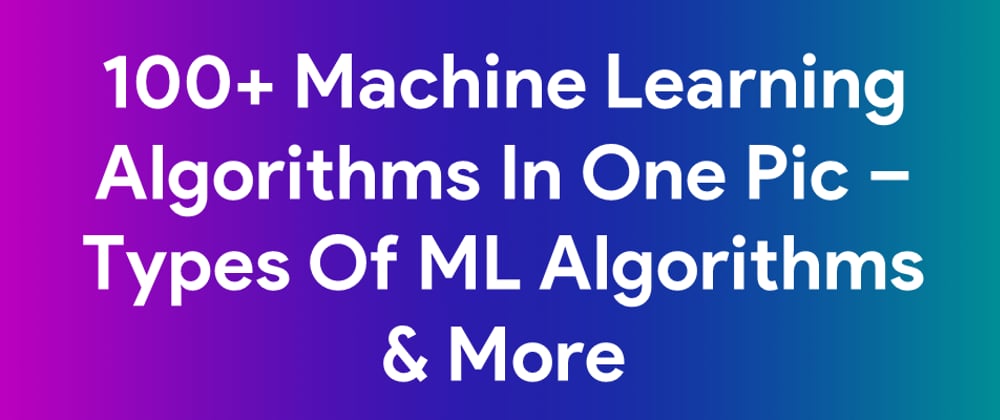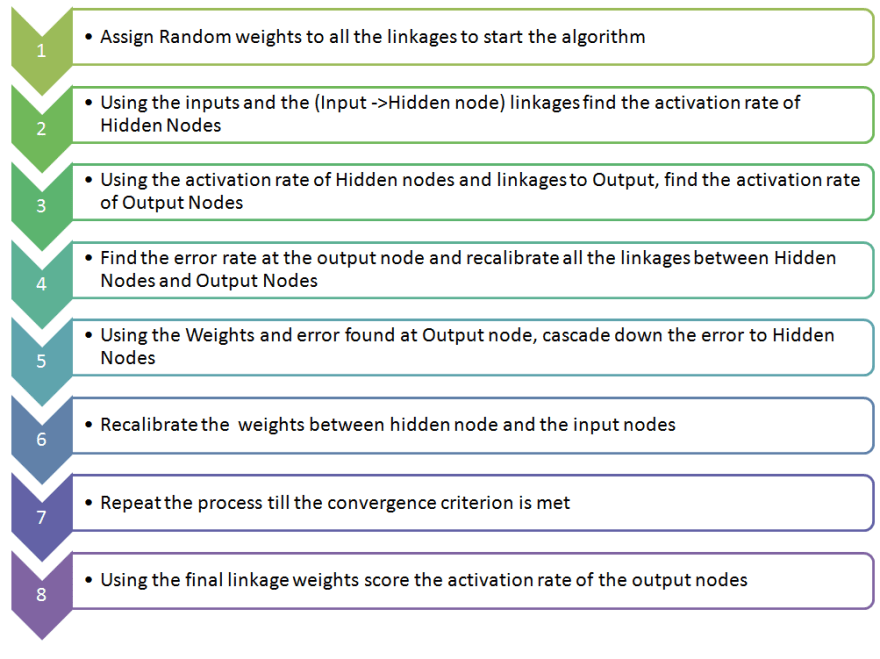In this post, I am going to share something very helpful for all machine learners or data science enthusiast. In this post, you'll find 100+ Machine Learning Algorithms in One Pic - A 2023 Tour for Machine Learners, Data Science Enthusiast and others who are interested in algorithms. This article will cover all the types of machine learning algorithms that you should know in 2023.
Download HQ PNG: 100+ Machine Learning Algorithms
Download PDF: 100+ Machine Learning Algorithms
Let's take a deep dive into types of machine learning algorithms
Machine learning Approaches and algorithms are generally classified into four broad categories: Supervised Learning, Unsupervised Learning, Semi-Supervised Learning and Reinforcement Learning
Supervised learning: Supervised learning is a type of ML where the model is provided with labeled input data and the expected output results. The AI system is specifically told what to look for, thus the model is trained until it can detect the underlying patterns and relationships, enabling it to yield good results when presented with never-before-seen data
For example, every shoe is labelled as a shoe and the same for the socks so that the system knows the labels, and when subjected to a new type of shoes, it will identify it as ‘shoes’ without being explicitly programmed to do so.
Unsupervised learning: No labels are given to the learning algorithm, leaving it on its own to find structure in its input. It's like learning on their own partially similar humans. In unsupervised learning, the goal is to identify meaningful patterns in the data. To accomplish this, the machine must learn from an unlabeled data set. In other words, the model has no hints how to categorize each piece of data and must infer its own rules for doing so.
Taking the same example which was discussed in supervised learning, here, the labels that are socks and shoes will be unknown to the interpreter, but the system will know that both are of different categories and places them accordingly.
Reinforcement learning: Reinforcement learning differs from other types of machine learning. In RL, A computer program interacts with a dynamic environment in which it must perform a certain goal (such as driving a vehicle or playing a game against an opponent). During training, the agent receives a reward when it performs this task, which is called a reward function. With reinforcement learning, the agent can learn very quickly how to outperform humans.
For Example, Consider the scenario of teaching new tricks to your pet (Let's consider it as your dog)
As dog doesn't understand English or any other human language, we can't tell him directly what to do. Instead, we follow a different strategy. We emulate a situation, and the dog tries to respond that situation in various ways. If the dog's response is the desired way, we will give him his tasty food. Now whenever the dog is exposed to that same situation, the dog executes a similar action with even more enthusiastically in expectation of getting more reward (food). This is one of the best example of reinforcement learning
Semi-Supervised Learning: Semi-supervised learning is a type of machine learning in which the algorithm is trained upon a combination of both labeled as well as unlabeled data during the training. Semi-supervised learning falls between unsupervised learning (with no labeled training data) and supervised learning (with only labeled training data).
For example, Imagine you want to classify content available on internet like google does, then labeling each webpage is an almost an impossible process and thus you need to use Semi-Supervised learning algorithms and other methods to do so. According to one blog published by Google AI, they have mentioned that Google search algorithm uses a variant of Semi-Supervised learning to rank the relevance of a webpage for a given query.
Related Post: 30 Machine Learning Projects For Beginners And Final Year Students
Now, its time to take a little deep dive into the types of machine learning algorithms. Let's begin with Regression..
👉 Regression Algorithms
Regression is one of the most important and broadly used machine learning and statistics method out there. It allows you to make predictions from data by learning the relationship between features of your data and some observed, continuous-valued response. Regression is used in a massive number of applications ranging from predicting stock prices to understanding gene regulatory networks.
The most widely used regression algorithms are:
- Linear Regression
- Logistic Regression
- Stepwise Regression
- Ordinary Least Squares Regression (OLSR)
- Multivariate Adaptive Regression Splines (MARS)
- Locally Estimated Scatterplot Smoothing (LOESS)
👉 Deep Learning Algorithms
According to Peter Norvig, the Director of Research at Google & the author of one of the best AI Books “Artificial Intelligence: A Modern Approach“, Deep Learning is a kind of learning where the representation you form have several levels of abstraction, rather than a direct input to output.
In short, Deep learning models teaches computers to do what comes naturally to humans i.e. learn by example. Deep learning methods are the main power behind driverless cars, enabling them to recognize a stop sign, or to distinguish a pedestrian from a lamppost. It is the key to voice control in consumer devices like phones, tablets, TVs, and hands-free speakers.
Taking Deep Learning Algorithms into consideration, Here's the list of most popular Deep Learning Algorithms you should know as a Machine Learning or Data Science Enthusiast
- Convolutional Neural Network (CNN)
- Recurrent Neural Networks (RNNs)
- Long Short-Term Memory Networks (LSTMs)
- Stacked Auto-Encoders
- Deep Boltzmann Machine (DBM)
- Deep Belief Networks (DBN)
👉 Bayesian Algorithms
A family of algorithms where all of them share a common principle, i.e. every pair of features being classified is independent of each other. Bayesian machine learning algorithms are based on Bayes theorem which is nothing but calculation of probability of something happening knowing something else has happened. Moving towards the types of Essential Bayesian Algorithms, here's the list..
- Naive Bayes
- Gaussian Naive Bayes
- Multinomial Naive Bayes
- Averaged One-Dependence Estimators (AODE)
- Bayesian Belief Network (BBN)
- Bayesian Network (BN)
👉 Neural Network Algorithms or ANN Algorithms
Artificial neural networks (ANNs), generally known as neural networks (NNs) are fairly similar to the human brain. They are made up of artificial neurons which takes multiple inputs and gives out a single output. Simply, ANNs consist of a layer of input nodes and layer of output nodes, connected by one or more layers of hidden nodes. Input layer nodes pass information to hidden layer nodes by firing activation functions, and hidden layer nodes fire or remain dormant depending on the evidence presented. The hidden layers apply weighting functions to the evidence, and when the value of a particular node or set of nodes in the hidden layer reaches some threshold, a value is passed to one or more nodes in the output layer.
The below given image shows the framework of how artificial neural network works.
Different types of ANN Algorithms are
- Perceptron
- Multilayer Perceptrons (MLP)
- Back-Propagation
- Stochastic Gradient Descent
- Hopfield Network
- Radial Basis Function Network (RBFN)
Related Post: 100+ Best And Free Machine Learning Courses
👉 Instance-Based Algorithms
This supervised machine learning algorithm performs operations after comparing current instances with previously trained instances that are stored in memory. This algorithm is called instance based because it is using instances created using training data. Some of the most popular instance based algorithms are listed below
- k-Nearest Neighbor (kNN)
- Learning Vector Quantization (LVQ)
- Self-Organizing Map (SOM)
- Locally Weighted Learning (LWL)
- Support Vector Machines (SVM)
👉 Regularization Algorithms
Regularization is a technique which makes slight modifications to the learning algorithm such that the model generalizes better. This in turn improves the model’s performance on the unseen data as well. These techniques or algorithms are used in conjunction with regression or classification algorithms to reduce the effect of over-fitting in data. Tweaking of these algorithm allows to find the right balance between training the model well and the way it predicts. The list of most widely used regularization algorithms are
- Ridge Regression
- Least Absolute Shrinkage and Selection Operator (LASSO)
- Elastic Net
- Least-Angle Regression (LARS)
👉 Decision Tree Algorithms
Decision Tree algorithm belongs to the family of supervised learning algorithms. Unlike other supervised learning algorithms, the decision tree algorithm can be used for solving regression and classification problems too.
The goal of using a Decision Tree is to create a training model that can use to predict the class or value of the target variable by learning simple decision rules inferred from prior data(training data).
In Decision Trees, for predicting a class label for a record we start from the root of the tree. We compare the values of the root attribute with the record’s attribute. On the basis of comparison, we follow the branch corresponding to that value and jump to the next node. The most popular decision tree algorithms are given below
- Chi-squared Automatic Interaction Detection (CHAID)
- Classification and Regression Tree (CART)
- Iterative Dichotomiser 3 (ID3)
- C4.5 and C5.0
- Conditional Decision Trees
- Decision Stump
- M5
👉 Clustering Algorithms
Making bunch of similar type of things is called clustering. In ML Terms, Clustering is a Machine Learning technique that involves the grouping of data points. Given a set of data points, we can use a clustering algorithm to classify each data point into a specific group.
- k-Means
- k-Medians
- Expectation Maximization (EM)
- Hierarchical Clustering
- Minimum spanning tree
- BIRCH
- Fuzzy C-Means
- Fuzzy K-Modes
- Mini Batch K-Means
- DBSCAN
- Fuzzy clustering
- Mean-shift
- OPTICS algorithm
👉 Dimensionality Reduction Algorithms
Dimensionality reduction is an unsupervised learning technique. This machine learning technique help us in reducing the dimensions of our data which in turn reduces the over-fitting in our model and reduces high variance on our training set so that we can make better predictions on our test set. Some of the most popular and widely used dimensionality reduction algorithms are
- Principal Component Analysis (PCA)
- Principal Component Regression (PCR)
- Partial Least Squares Regression (PLSR)
- Sammon Mapping
- Multidimensional Scaling (MDS)
- Projection Pursuit
- Linear Discriminant Analysis (LDA)
- Independent component analysis (ICA)
- Non-negative matrix factorization (NMF)
- Regularized Discriminant Analysis (RDA)
- Mixture Discriminant Analysis (MDA)
- Partial Least Squares Dimension Analysis (PLSDA)
- Quadratic Discriminant Analysis (QDA)
- Canonical correlation analysis (CCA)
- Flexible Discriminant Analysis (FDA)
- Diffusion map
Read More from here: Ensemble Algorithms, Association Rule Learning Algorithms, Rule Based System, Reinforcement Learning Algorithms & Other Machine Learning Algorithms



















Top comments (0)